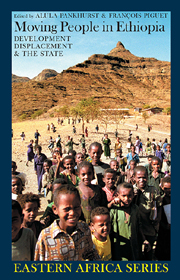Book contents
- Frontmatter
- Contents
- Acknowledgements
- Acronyms
- Glossary
- Notes on Contributors
- Preface: An Original Contribution to Country-wide Displacement Analysis
- Foreword by Alula Pankhurst & François Piguet
- Map
- Part I INTRODUCTION
- Part II THEORETICAL & INTERNATIONAL PERSPECTIVES
- Part III DEVELOPMENT-INDUCED DISPLACEMENT
- 4 Social Dimensions of Development-Induced Resettlement
- 5 The Effects of Development Projects on the Karrayu & Afar in the mid-Awash Valley
- 6 The Effects of Investment on the Livelihoods of the Tsamako in the Wayto Valley
- 7 Planning Resettlement in Ethiopia
- 8 Urban Development & Displacement of Rural Communities around Addis Ababa
- Part IV THE EXPERIENCE OF STATE-ORGANIZED RESETTLEMENT
- Part V THE DILEMMAS OF REFUGEES, RETURNEES & DISPLACED GROUPS
- Part VI CONCLUSION
- Bibliography
- Index
- EASTERN AFRICAN STUDIES
4 - Social Dimensions of Development-Induced Resettlement
from Part III - DEVELOPMENT-INDUCED DISPLACEMENT
Published online by Cambridge University Press: 05 April 2013
- Frontmatter
- Contents
- Acknowledgements
- Acronyms
- Glossary
- Notes on Contributors
- Preface: An Original Contribution to Country-wide Displacement Analysis
- Foreword by Alula Pankhurst & François Piguet
- Map
- Part I INTRODUCTION
- Part II THEORETICAL & INTERNATIONAL PERSPECTIVES
- Part III DEVELOPMENT-INDUCED DISPLACEMENT
- 4 Social Dimensions of Development-Induced Resettlement
- 5 The Effects of Development Projects on the Karrayu & Afar in the mid-Awash Valley
- 6 The Effects of Investment on the Livelihoods of the Tsamako in the Wayto Valley
- 7 Planning Resettlement in Ethiopia
- 8 Urban Development & Displacement of Rural Communities around Addis Ababa
- Part IV THE EXPERIENCE OF STATE-ORGANIZED RESETTLEMENT
- Part V THE DILEMMAS OF REFUGEES, RETURNEES & DISPLACED GROUPS
- Part VI CONCLUSION
- Bibliography
- Index
- EASTERN AFRICAN STUDIES
Summary
Introduction
The numbers of people affected by Development-Induced Displacement (DID) have been rising steadily, and Dam-Induced Displacement is an important part of this, with effects that have long been studied, particularly in Africa with the Kariba Dam (Colson 1971; Scudder 1996; Cernea 2000). In Ethiopia people are internally displaced regularly for various reasons but the literature has been dominated by studies dealing with resettlement and villagization. The first major dam-induced displacement in Ethiopia resulted from the construction of the Gilgel Gibe dam. The project was conceived during the late imperial period, after the Koka dam built in the late 1950s (S. Pankhurst 1958) was found to be insufficient to meet the country's growing electricity needs and was closed down. However, only a reconnaissance report had been produced by the time of the revolution in 1974. During the Derg period several feasibility studies were undertaken and construction and relocation of some 10,000 people began in 1985 but was interrupted and only resumed in 1996 after the EPRDF took power. The EPRDF government, with the support of the World Bank, embarked on the Gilgel Gibe Project (GGP), the second largest Bank-supported resettlement operation in Africa at that time.
- Type
- Chapter
- Information
- Moving People in EthiopiaDevelopment, Displacement and the State, pp. 49 - 65Publisher: Boydell & BrewerPrint publication year: 2009



